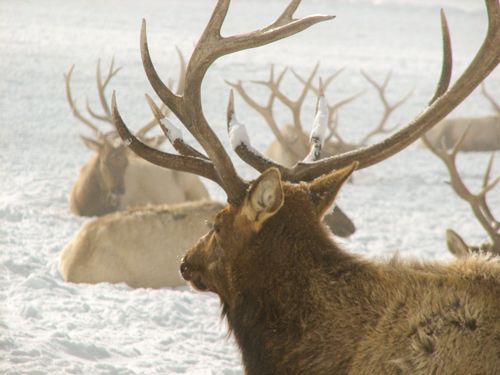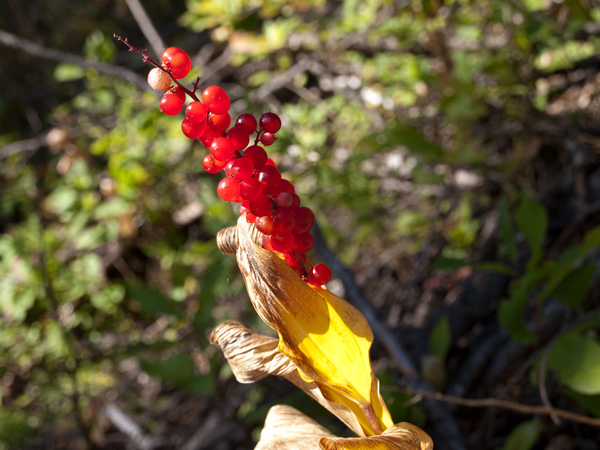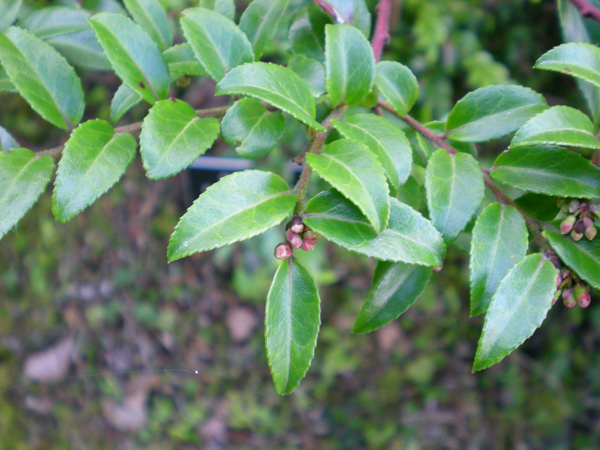Pvt. Shannon returns to Fort Clatsop with news of ten elk ready to be brought in. Lewis compares how he and the Chinookan People treat gonorrhea and syphilis and adds two plants to his collection.
Every Man Out to Retrieve Elk
by Yellowstone Public Radio[1]Originally aired weekdays by Yellowstone Public Radio during the Bicentennial observance of 2003-2006. Narrated by Hal Hansen. Scripts by Whit Hansen and Ed Jacobson. Produced by Leni Holliman. © … Continue reading
An Elk Bonanza
in the evening Shannon returned and reported that himself and party had killed ten Elk. he left Labuche [Labiche] and R. fields with the Elk. two of those Elk he informed us were at the distance of nine miles from this place near the top of a mountain, that the rout by which they mus be brought was at least four miles by land through a country almost inaccessible from the fallen timber, brush and sink-holes, which were now disgused by the snow;
—Meriwether Lewis
Treating Goodrich
Goodrich has recovered from the Louis veneri which he contracted from an amorous contact with a Chinnook damsel. I cured him as I did Gibson last winter by the uce of murcury.
—Meriwether Lewis
Treating “the Louis veneri”
I cannot learn that the Indians have any simples which are sovereign specifics in the cure of this disease [syphilis]; and indeed I doubt very much wheter any of them have any means of effecting a perfect cure. . . . . in my whole rout down this river I did not see more than two or three with the gonnaerea [gonorrhea] and about double that number with the pox.—
—Meriwether Lewis
False Solomon’s-seal, Smilacina racemosa
Historic Lolo Trail near Travelers’ Rest
© 10 September 2008 by Kristopher K. Townsend. Permission to use granted under the Creative Commons Attribution-Share Alike 4.0 International license.
False Solomon’s-seal
The beary which the natives call solme is the production of a plant about the size and much the shape of that common to the atlantic states which produces the berry commonly called Solloman’s seal berry.
—Meriwether Lewis
Huckleberry Specimen
A Shrub of 7 or 8 feet high, Supposed to be a Species of Vaccinium; the berries are eaten by the natives. On the Pacific Oean Fort Caltsop. Jan: 27th 1806.
—Meriwether Lewis[2]Vaccinium ovatum. Moulton, ed. Herbarium, specimen 173.
Weather Diary
aspect of the weather at rise
Wind at rise
Weather at 4 OC. P.M. Wind at 4 OC. P.M. fair after snow N. E fair N. E the sun shone more bright this morning than it has done since our arrival at this place. the snow since 4 P. M. yesterday has increased to the debth of 6 Inches, and this morning is perceptibly the couldest that we have had. I suspect the Murcury would stand at about 20° above naught; the breath is perceptible in our room by the fire.
—Meriwether Lewis[3]To assist the reader, the editor of this web page has omitted the “Day of the month” column and spelled out some abbreviations.
Experience the Lewis and Clark Trail
The Lewis and Clark Trail Experience—our sister site at lewisandclark.travel—connects the world to people and places on the Lewis and Clark Trail.
Plan a trip related to January 27, 1806:

Fort Clatsop is a High Potential Historic Site along the Lewis and Clark National Historic Trail managed by the U.S. National Park Service. The site is managed by the Lewis and Clark National and State Historic Parks.
Notes
| ↑1 | Originally aired weekdays by Yellowstone Public Radio during the Bicentennial observance of 2003-2006. Narrated by Hal Hansen. Scripts by Whit Hansen and Ed Jacobson. Produced by Leni Holliman. © 2003 by Yellowstone Public Radio. |
|---|---|
| ↑2 | Vaccinium ovatum. Moulton, ed. Herbarium, specimen 173. |
| ↑3 | To assist the reader, the editor of this web page has omitted the “Day of the month” column and spelled out some abbreviations. |





